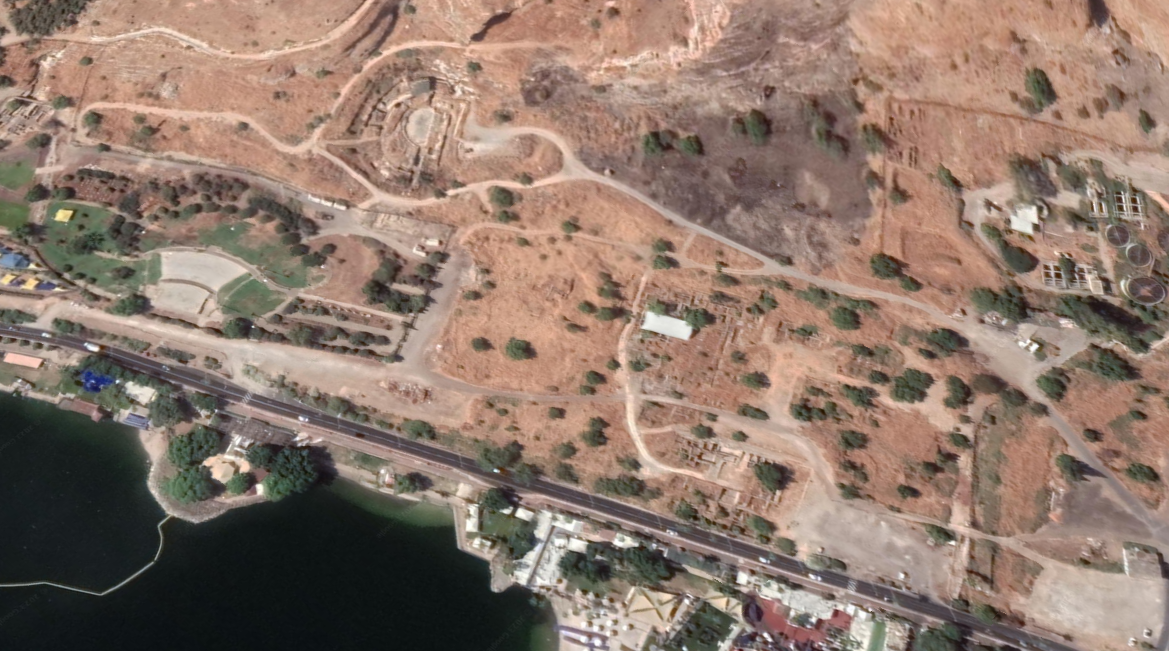Tiberias Introduction
| Transliterated Name | Language | Name |
|---|---|---|
| Tverya | Hebrew | טיבריות |
| Ṭabariyyā | Arabic | طبريا |
| Rakkath | Biblical Hebrew (Joshua 19:35) | רקבת |
| Chamath | Ancient Israelite (Jewish tradition) | חמת |
| Tiberiás | Ancient Greek | Τιβεριάς |
| Tiveriáda | Modern Greek | Τιβεριάδα |
| Tiberiás | Latin | Tiberiás |
| Tiberias | English | Tiberias |
Tiberias was founded between 18 and 20 CE by Herod's son Herod Antipas, who made it the capital of his kingdom; the city was named after the Roman Emperor Tiberius. Its location, on the western shore of the Sea of Galilee was then to the south of present-day Tiberias and to the north of the hot springs known as Hammath; the city's western boundary was marked by Mount Berenice, which rises to an altitude of approximately 200m above the level of the Sea of Galilee (Stern et al, 1993). In the 3rd century CE, the ruling institutions of the Jewish people moved to Tiberias and Tiberias became the Jewish capital of Palestine and the diaspora. The majority of the Palestinian (aka Jerusalem) Talmud was composed there (Stern et al, 1993). The city began to decline and moved north to present day Tiberais in the 9th and 10th centuries (Stern et al, 1993).
Tiberias was founded between 18 and 20 CE by Herod's son Herod Antipas, who made it the capital of his kingdom; the city was named after the emperor Tiberius. Its location, on the western shore of the Sea of Galilee (map reference 201.242) was then to the south of present-day Tiberias and to the north of the hot springs known as Hammath; the city's western boundary was marked by Mount Berenice, which rises to an altitude of approximately 200 m above the level of the Sea of Galilee.
Josephus states that Tiberias was located "in the best region of Galilee." In order to populate the city as quickly as possible, the king attracted residents "by equipping houses at his own expense and adding new gifts of land" (Antiq. XVIII, 36-38). Coins issued in honor of the founding of the city feature the reed plants indigenous to the shores of the Sea of Galilee; later coins, minted toward the end of the Second Temple period, bear a palm tree, symbolizing the city's prosperity.
According to Josephus, the royal palace was a magnificent building, that was decorated with "representations of animals," and whose ceilings were "partly of gold" (Life 65-66). The royal treasure houses and archives were also here, at least until61 CE when Tiberias lost its role as the capital (Life 38). Josephus also mentions a synagogue, which was "a huge building, capable of accommodating a large crowd" (Life 277). After the death of Herod Anti pas' successor, Agrippa I ( 44CE), Tiberias came under the authority of the Roman procurators of Judea. The town maintained its position as the capital of Galilee without interruption until 61, when it was annexed to the kingdom of Agrippa II (Life 37-38), whose capital was at Caesarea-Philippi (modern Banias). As Agrippa's sister Berenice ruled at his side in Banias, the popular tradition linking her name to the mountain and aqueduct in Tiberias has no historical basis. At the outbreak of the First Jewish Revolt against Rome in 66, Tiberias was fortified with walls that remained standing even after the city had surrendered to the Roman army (War II, 572-573; III, 460-461).
Tiberias continued to be part of Agrippa II's kingdom, probably until his death in about 96. Then the town came under direct Roman rule and enjoyed the prosperity characteristic of the Roman Empire. During Hadrian's reign, a temple was built in his honor (the Hadrianeum, "a very great temple" according to Epiphanius, H aer. 30, 12). Its four-columned facade is depicted on a series of coins minted at Tiberias in 119. In the mid-second century the city, previously considered unclean because of the many old graves in it, was purified by Rabbi Simeon Bar Yohai (Gen. Rab. 79h; J.T., Shah. 9, l-38d).
During the reign of Emperor Elagabalus (218-222), Tiberias was granted the status of a Roman colony, as it appears from coins (B.T., A.Z. lOa). It was then that the ruling institutions of the Jewish people were moved from Sepphoris to Tiberias: first (c. 235) the Sanhedrin, with Rabbi Yohanan at its head, then the Patriarchate, and the then reigning patriarch, Rabbi Judah II Nesiah (d. c. 270). Yohanan established the Great Study House (beth ha midrash ha-gadol). In this institution, frequently mentioned in Talmudic literature, the great majority of the Palestinian (Jerusalem) Talmud was written.
After Tiberias became the Jewish capital of Palestine and the Diaspora, it continued to prosper for a considerable time. The sources refer to the city gate and to the fortress, which was probably built on the site of the royal palace from Second Temple times. Mention is also made of the boule (municipal council), various synagogues, study houses, city markets, and a series of public buildings-a stadium, bathhouse, lavatory, and magnificent tombs. Near these were the residential quarters of the city and various industrial areas, which included, inter alia, glassworks and pottery workshops. South of Tiberias, in the vicinity of the hot springs, Hammath-Tiberias (q.v.) developed as a suburb serving the numerous visitors who came from far and near to the medicinal springs.
In the sixth century, the Academy (Yeshiva) of Bretz-Israel, which succeeded the Sanhedrin as the supreme religious institution of the Jewish people, was established in Tiberias. The academy continued its activities here long after the Arab occupation, probably until the tenth century. During that time-the period of the Gaonim-several schools of poets and preachers were active in Tiberias, as were scribes and vocalizers (the Masoretes), whose system of vocalization, still in use today, is known as the Tiberian system.
After the Arab invasion, Tiberias superseded Beth-Shean as the capital of northern Palestine. The city continued to prosper until the ninth century. In the tenth century, however, security in the area began to deteriorate and the population declined. In 1033, Tiberias was destroyed by an earthquake; in the Crusader period, it was moved to the north, to its present location. Since then, most of the area of ancient Tiberias has remained desolate.
The foundation date of Tiberias is not certain. Named after Tiberius (reigned 14–37 CE), it is believed to have been founded by Herod Antipas, son of Herod the Great, as his capital some-time between 18 and 20. In 39 Antipas’s nephew, Agrippa I, gained control over the city and ruled it up to his death in 44 CE. Until 61 CE it was ruled by the procurators, when its political status changed when it was annexed to the kingdom of Agrippa II, whose capital was at Banias. In about 100 CE it came under direct Roman rule. During Hadrian’s reign (117–138 CE) there commenced the erection of a temple in his honor in the middle of the city, which, however, was never finished.
In the third century, Tiberias flourished: not only was it granted the status of a Roman colony (under Elagabalus [reigned 218–222 CE]), but also it became the capital of the Jewish people, after the Sanhedrin, the Patriarchate, and the leader of the community all had moved there from Sepphoris. Rabbi Yohanan, head of the Sanhedrin, established the bet ha-midrash ha-gadol, where the Palestinian Talmud was mostly written. From the sixth century on, Yeshivat Eretz Israel, the supreme religious institution for the Jews in Palestine and the Diaspora, was active in Tiberias, at least until the tenth century (of note is the fact that the Aleppo Codex was compiled in Tiberias at this time), when it finally moved to Jerusalem. Even then, Tiberias continued to serve as a center for the Masoretes, who dealt with the correct vocalization of the Holy Scriptures, for Hebrew grammarians, as well as for poets and preachers.
The prominent Jewish character of Tiberias might have been the main reason the Christian community did not take off, at least until the fifth century.2 Yet, despite the slow penetration of Christianity into Tiberias, we know that by the mid-fifth century it is already a seat of a bishopric, as its bishop (John) is mentioned in the lists of the Council of Chalcedon (451 CE).3
Tabariyya, as it is named in Arabic, was conquered by Arab armies in 635 CE. According to al-Baladhuri (d. c. 892)4, the terms of surrender guaranteed a smooth and peaceful change of government. Eventually Tabariyya was chosen to be the capital of Jund al-Urdunn, ultimately to the detriment of Baysān/Scythopolis, capital of Palaestina Secunda. It is not clear,nevertheless, when exactly this shift of capitals took place.
Three major earthquakes affected Tiberias during the Early Islamic period: 749 CE, 1033 CE, and 1068 CE. The first certainly caused much destruction, as we learn from the excavations at Galei Kinneret,5 but the earthquake was followed by renovation, building, and expansion. The earthquake of 1033, until recently thought to have brought Tiberias to an end, was not as dramatic for Tiberias. The account of the Persian traveler Nasir-i Khusraw of 1047 CE makes no reference to a devastated city, quite the opposite:6
The city has a strong wall that, beginning at the borders of the lake, goes all round the town; but on the water side there is no wall. There are numerous buildings erected in the very water, for the bed of the lake in this part is rock; and they have built pleasure-houses that are supported on columns of marble, rising up out of the water. The lake is full of fish.Nasir-i Khusraw goes on, describing the Friday Mosque in the middle of the town, as well as another one called Jasmine Mosque, on the western side of the city.
In addition to natural disasters, Islamic Tiberias was hit by invasions and sacking. In 906 CE the Ismaili Qarmatis, fighting against the Tulunids for the leadership of Syria, captured Tiberias, a major army base at the time. The sources tell that, following the resistance of its people, the city was plundered, women taken captive, and many people killed7. The eleventh century was even harder for Tiberians, as in general for the people of Palestine. Even before the earthquake of 1033 CE8, drought and unrest had struck the region. The Banu Jarrah Bedouin caused much instability. In August 1024 CE, their leader al-Hassan b. al-Mufarrij sacked Tiberias and killed its people mercilessly.9
Not withstanding the unrest, southern Syria under the Fatimids — and especially its two capitals, Ramla and Tiberias — witnessed a golden age. Much building and commercial, cultural, and religious activities took place. But toward the 1050s–1060s, the situation changed again, this time creating a political vacuum from which it was dfficult to recover. Jewish letters found in the Geniza are testimony to the stress under which the population of Syria lived.10 This situation, among others, made room for the Seljuq invasion of the 1070s, when Tiberias was made the Seljuq base against the Fatimids.11
In August 1098, the Fatimids managed to regain Jerusalem from the Seljuq Turks, putting an end to their rule over Palestine. Yet the Fatimids’ hold was short, and in July 1099 Palestine fell into the hands of the Crusaders. The old city center of Tiberias became a quarry for building material to the newly established Crusader fortfication to the north of the city.12
2 The Panarion of Epiphanius (fourth century) includes a passage that seems representative of the Jewish sovereignty in Tiberias,
despite being under Christian rule. The passage refers to Count (Comes) Joseph from Tiberias, a Jew converted to Christianity and protégée of
Constantine (reigned 306–337 CE). He planned to build a church at the site of the unfinished Hadrianeum, but the local Jews often
disrupted his works. So he eventually built a small church at the site of the temple, left the city, and settled in Beth She’an. See
The Panarion of Epiphanius of Salamis (trans. F. Williams; Nag Hammadi Studies 35; Leiden: Brill, 1987), book 1, sections 1–46, §30.12,1–12,9.
3. R. Price and M. Gaddis, trans., The Acts of the Council of Chalcedon (Translated Texts for Historians 45;Liverpool: Liverpool University Press, 2005), 1:360.
4. Ahmad ibn Yahyā ibn Jābir al-Balādhurī, Futūh al-buldān (Leiden: Brill, 1866), 115–16
5. License no. A-3607. Moshe Hartal, “Tiberias, Galei Kinneret,” HA-ESI 120 (2008)
6. Nāsir-i Khusraw, Safarnāma, ed., Yahyā al-Khashshāb (Beirut: Dār al-Kitāb al-Jadīd, 1983), 52.
7. Moshe Gil, A History of Palestine, 634–1099 (Cambridge: Cambridge University Press, 1997), §468.
8. A further earthquake, which took place in September 1015, is recorded by the sources, but apparently it was of little consequence,
the main result being the collapse of the dome at the Dome of the Rock in Jerusalem. See ibid., §581. For the earthquake of 1033 and 1068, see ibid.,
§§595 and 602.
9. Ibid., §585.
10. Ibid., §596.
11. Ibid. §603.
12. On this fortfication, see Yosef Stepansky, “The Crusader Castle of Tiberias,” Crusades 3 (2004): 179–81.
- from Zohar (2017)
The prosperity of the Jewish community did not last long and sometime at the beginning of the seventeenth century the Jews were forced to leave due to Ottoman tyranny (Roger 1646, De Thévenot 1971). The turning point for Tiberias was the rule of Dahir al-Umar of the Bedouin Zaydan family. Close to the mid-eighteenth century he gained control of Tiberias and other Galilean regions and gradually accumulated massive power. His dominancy did not escape the eyes of Suleiman, the Pasha of Damascus, who decided to overthrow Dahir’s rule by besieging Tiberias three times: in 1738, 1742 and 1743. The first two sieges were failures and during the last attempt Suleiman died of an intestine illness (Bnayahu 1946, Heyd 1969, Nachshon 1980). The son of Dahir, Chulaybi, had fewer confrontations but, like his father, kept strengthening Tiberias and in 1750 also built a citadel on a hill at the northwest corner of the city (Hasselquist 1766). In October and November 1759, the walls and the Citadel were severely hit by two consecutive earthquakes (Ambraseys and Barazangi 1989, Ambraseys 2009), but were gradually restored towards the end of the nineteenth century (Mariti 1791).
In October 1831 the Egyptian Ibrahim Pasha invaded Palestine on his way north and in May 1833 he completed the conquest of Syria and Palestine. In 1834 another damaging earthquake struck Palestine but no damage to Tiberias or northern Palestine was reported (Ambraseys 2009). In the same year a Fellahin rebellion erupted in the mountainous areas of Bethlehem, Jerusalem, Nablus, Transjordan and northern Galilee. The rebels took over Tiberias for a short period but the Egyptians, with reinforcements from the south, eventually managed to gain back control of the city (Ben-Zvi 1954). From that year until the 1837 earthquake the city remained under Egyptian rule.
The remains of ancient Tiberias' walls were first examined by V. Guerin in 1875. A more detailed survey of the walls at the top of Mount Berenice was carried out by G. Schumacher in 1887. A systematic excavation of the southern gate and its vicinity was carried out by G. Foerster in 1973-1974, on behalf of the Israel Department of Antiquities and Museums, the Institute of Archaeology at the Hebrew University of Jerusalem, and the Israel Exploration Society. In addition, a great number of salvage excavations has been carried out. The largest, in both scale and results, was conducted in the center of the municipal area of the ancient city, under the direction of B. Rabani (1954- 1956). The excavators cleared a section of the city's central colonnaded street (its cardo), as well as a bathhouse and vaulted market. To the east, not far from the lake shore, A. Druks (1964-1968), uncovered the remains of a basilica! structure. When the excavations were extended to the south, along the shore, the remains of an exedra and various public buildings were revealed. In 1976, F. Vitto excavated a Roman tomb in Tiberias, and in 1989-1990 Y. Hirschfeld's salvage excavation at the foot of Mount Berenice exposed a Roman public building beneath the remains of private houses. Since 1990 Hirschfeld has been directing excavations on the summit of Mount Berenice.
The rapid development of modern Tiberias necessitated several salvage excavations in the southern part of the city. The remains of the Byzantine city wall and a large Crusader church were discovered by A. Harifin 1980, when foundations were dug for the Jordan River Hotel. Farther south, A. Berman, working in 1978-1979, had discovered the remains of a synagogue and private houses from the Byzantine and Early Arab periods.
Other salvage excavations in the area revealed the remains of churches and fortification systems from the Crusader period. Dozens of tombs were discovered in the area to the north and northwest of the Byzantine city wall, mainly on the slopes now occupied by modern Tiberias. The results of these salvage operations provide important data for a reconstruction of the city plan of Roman-Byzantine Tiberias.
- mostly from Ferrario et al. (2020) Supplemental
- all links open in a new tab
| Location | Studies | Notes |
|---|---|---|
| Galei Kinneret | Galei Kinneret Site is just south of what appears to be the Roman Stadium | |
| Berniki Theatre | ||
| Water Reservoir | ||
| Southern Gate | ||
| Aviv Hotel | ||
| Site 7354 | ||
| House of the Bronzes | ||
| Basilica | ||
| Gane Hammat | ||
| Mount Berineke |
- Fig. F Main archaeological sites
of Tiberias from Cytryn-Silverman (2015)

 Figure F
Figure F
Map of Tiberias, main archaeological sites
Prepared by Leticia Barda (Israel Antiquities Authority), adapted by Daniel Leviathan, The New Tiberias Excavation Project.
Cytryn-Silverman (2015) - Fig. 1 Map of Tiberias
during the Roman period from Atrash (2010)
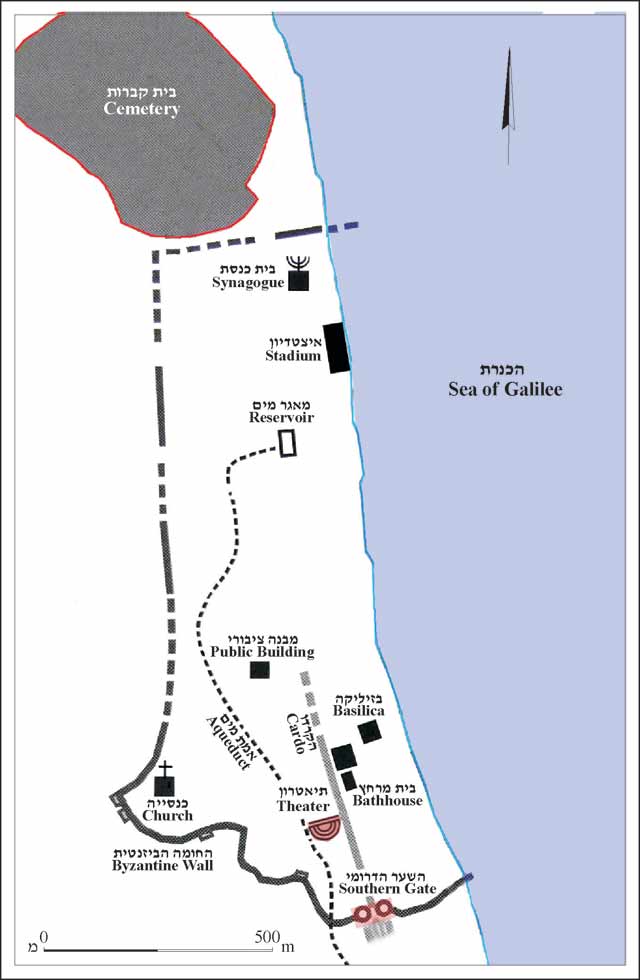
 Figure 1. The city during the Roman period, plan (based on Hirschfeld 1992)
Figure 1. The city during the Roman period, plan (based on Hirschfeld 1992)
Atrash (2010) - City plan of Tiberias
from Stern et al (1993 v.4)

 Tiberias: city plan
Tiberias: city plan
Stern et al (1993 v.4) - City center plan of
Tiberias from Stern et al (1993 v.4)
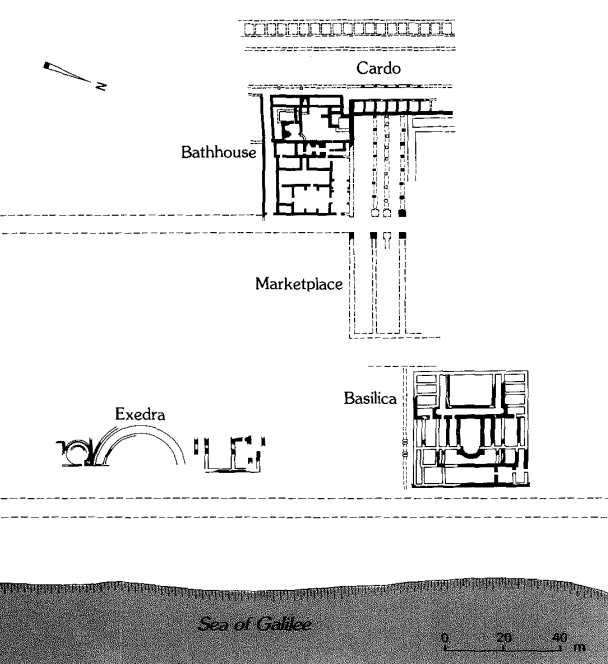
 Plan of the main buildings in the city center. Plan of the main buildings in the city center
Plan of the main buildings in the city center. Plan of the main buildings in the city center
Stern et al (1993 v.4) - City gate from Roman period
Tiberias from Stern et al (1993 v.4)

 Area C: plan of the city gate from the Roman period and Early Arab period structures nearby
Area C: plan of the city gate from the Roman period and Early Arab period structures nearby
Stern et al (1993 v.4) - City Plan and wall
in the 6th century CE from Stern et al (1993 v.4)

 Tiberias: plan of the city and the city wall in the 6th century CE
Tiberias: plan of the city and the city wall in the 6th century CE
Stern et al (1993 v.4)
- Fig. F Main archaeological sites
of Tiberias from Cytryn-Silverman (2015)

 Figure F
Figure F
Map of Tiberias, main archaeological sites
Prepared by Leticia Barda (Israel Antiquities Authority), adapted by Daniel Leviathan, The New Tiberias Excavation Project.
Cytryn-Silverman (2015) - Fig. 1 Map of Tiberias
during the Roman period from Atrash (2010)

 Figure 1. The city during the Roman period, plan (based on Hirschfeld 1992)
Figure 1. The city during the Roman period, plan (based on Hirschfeld 1992)
Atrash (2010) - City plan of Tiberias
from Stern et al (1993 v.4)

 Tiberias: city plan
Tiberias: city plan
Stern et al (1993 v.4) - City Plan and wall
in the 6th century CE from Stern et al (1993 v.4)

 Tiberias: plan of the city and the city wall in the 6th century CE
Tiberias: plan of the city and the city wall in the 6th century CE
Stern et al (1993 v.4)
- Annotated Aerial View of
Tiberias from BibleWalks.com
- Fig. A - Aerial view of
ancient Tiberias from Cytryn-Silverman (2015)
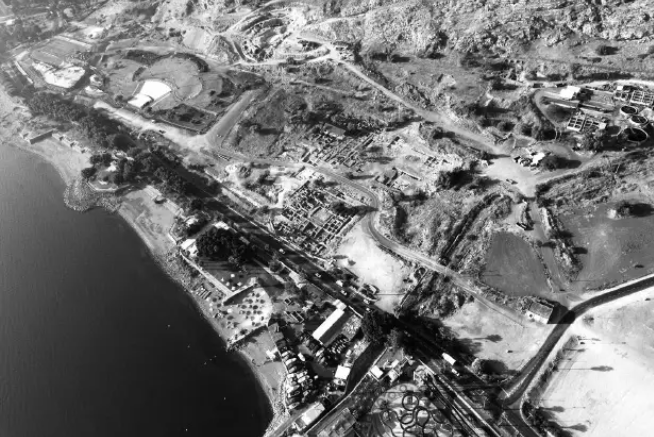
 Figure A
Figure A
Aerial view of ancient Tiberias, looking southwest
On the foreground remains of the basilical villa excavated by A. Druks and Y. Hirshfeld
To the west, the remains of the mosque and baths (under modern roof)
On the left, Berko Park with the remains of the Roman gate
On extreme right, Tiberias Sewage Treatment Plant, site of “The House of the Bronzes.”
Photo by David Silverman, The New Tiberias Excavation Project.
Cytryn-Silverman (2015) - Ancient Tiberias in Google Earth
- Ancient Tiberias on govmap.gov.il
- Fig. 4 Map of ancient Tiberias
with inferred fault from Ferrario et al (2020)

 Figure 4
Figure 4
Map of ancient Tiberias (modified after Hirschfeld & Gutfeld, 2008) with indication of the inferred lineament and trench position.
Ferrario et al (2020) - Fig. 1b Quaternary faults
around the Sea of Galilee and the Jordan Valley from Ferrario et al (2020)

 Figure 1b
Figure 1b
Quaternary faults in the central part of the DSF, modified after Sneh and Weinberger (2014), Sagy et al. (2016), Hamiel et al. (2016), and Sharon et al. (2018, 2020); the red rectangle is the area enlarged in Fig. 1c
- JVWB: Jordan Valley Western Boundary Fault
- JVF: Jordan Valley Fault
- G: Gilboa Fault
Ferrario et al (2020) - Fig. 1c Simplified geologic map
around the Sea of Galilee along with epicenters of MW > 4.0 events since 1970 from Ferrario et al (2020)

 Figure 1c
Figure 1c
Simplified geologic map (after Bogoch & Sneh, 2008; Sneh, 2008), epicenters of MW > 4.0 events since 1970 (data from http://seis.gii.co.il/en/earthquake/searchEQSRslt.php).
Ferrario et al (2020) - Fig. 10 Sketches of the shallow
subsurface from Ferrario et al (2020)
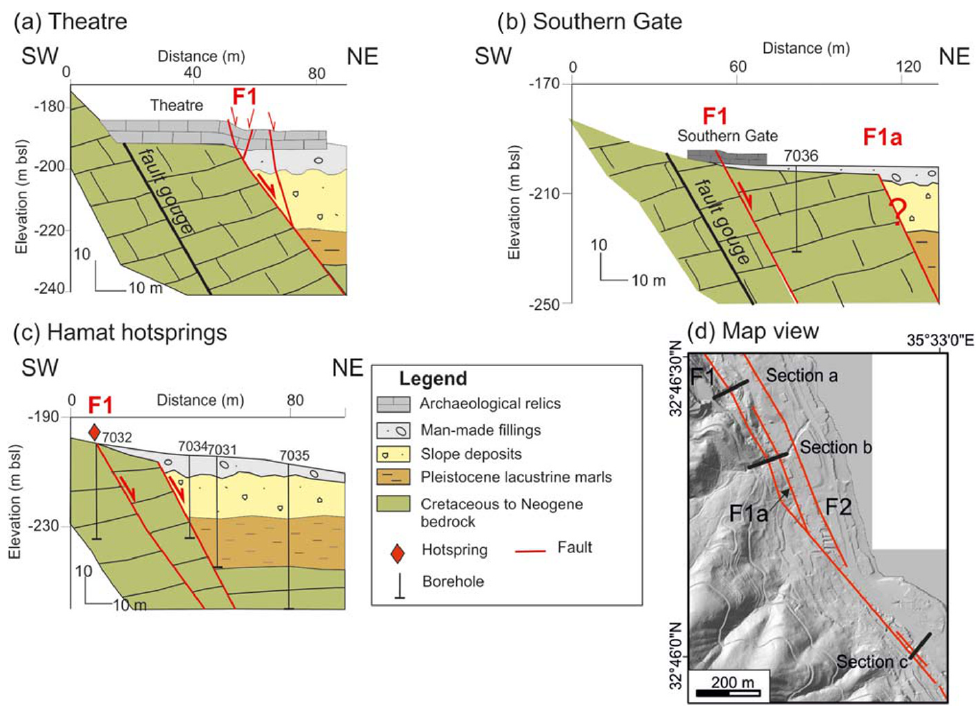
 Figure 10
Figure 10
Schematic sketches of the shallow subsurface at three key positions
- Theater
- Southern Gate
- Hamat hot springs
- section traces
Information on geology is derived from the Israeli geological map (Sneh, 2008), published scientific literature (e.g., Hurwitz et al., 2002), and local reports (e.g., Zaslavsky, 2009). Borehole logs are from GSI archive
Ferrario et al (2020) - Fig. 2b Morphotectonic map
from Ferrario et al (2020)
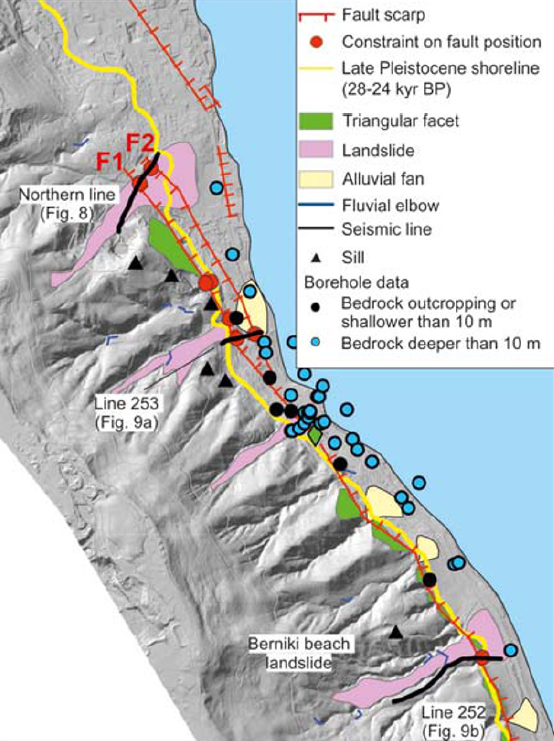
 Figure 2b
Figure 2b
morphotectonic map of the study area, based on 0.5 m resolution DTM extracted from airborne Lidar survey. The map shows also the late Pleistocene shoreline, the position of boreholes analyzed in this study, and the points where we constrained the spatial position of the fault trace.
Ferrario et al (2020) - Fig. 9 Interpreted Seismic
lines from Ferrario et al (2020)

 Figure 9
Figure 9
Seismic lines and relative interpretation
- Southern Gate, location of the trench is also shown
- Berniki Beach landslide
- Traces of the seismic lines
Ferrario et al (2020) - Fig. 8 Interpreted Seismic line
run north of Tiberias Theater from Ferrario et al (2020)
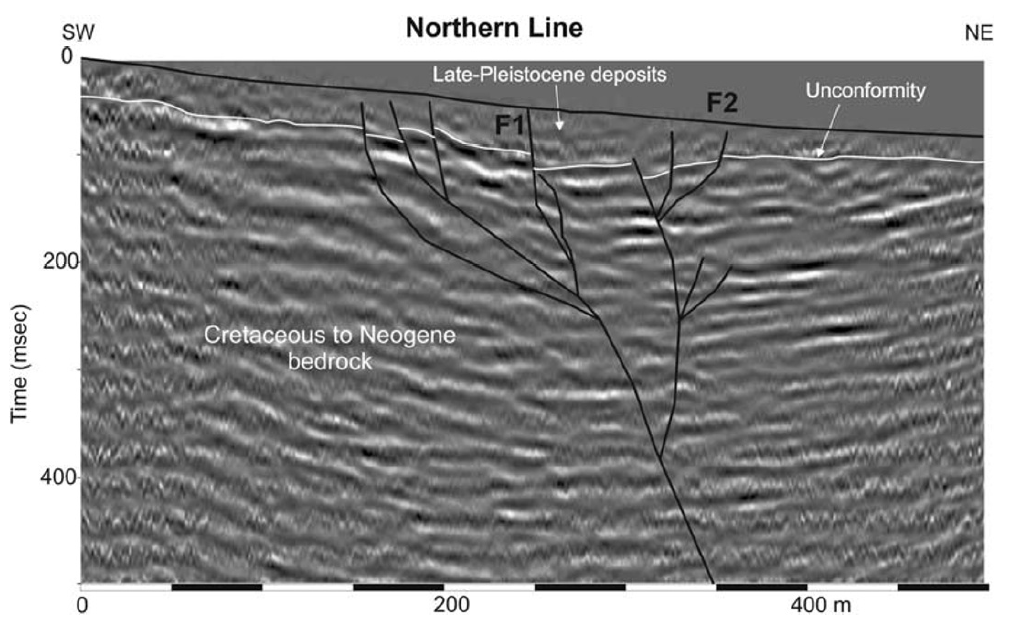
 Figure 8
Figure 8
Seismic line run north of Tiberias Theater and relative interpretation; trace in Figure 9.
Ferrario et al (2020) - Fig. 2a Site Map
from Ferrario et al (2020)
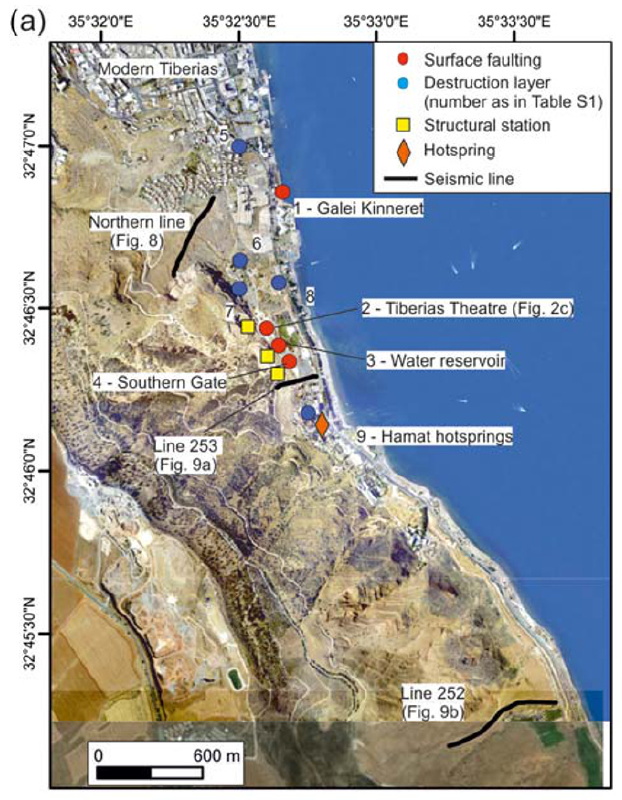
 Figure 2a
Figure 2a
Relevant sites mentioned in the text and location of the seismic lines; numbers correspond to Table S1 in the supporting information where relevant references are provided
Ferrario et al (2020)
- Fig. 1b Quaternary faults
around the Sea of Galilee and the Jordan Valley from Ferrario et al (2020)

 Figure 1b
Figure 1b
Quaternary faults in the central part of the DSF, modified after Sneh and Weinberger (2014), Sagy et al. (2016), Hamiel et al. (2016), and Sharon et al. (2018, 2020); the red rectangle is the area enlarged in Fig. 1c
- JVWB: Jordan Valley Western Boundary Fault
- JVF: Jordan Valley Fault
- G: Gilboa Fault
Ferrario et al (2020) - Fig. 2b Morphotectonic map
from Ferrario et al (2020)

 Figure 2b
Figure 2b
morphotectonic map of the study area, based on 0.5 m resolution DTM extracted from airborne Lidar survey. The map shows also the late Pleistocene shoreline, the position of boreholes analyzed in this study, and the points where we constrained the spatial position of the fault trace.
Ferrario et al (2020) - Fig. 9 Interpreted Seismic
lines from Ferrario et al (2020)

 Figure 9
Figure 9
Seismic lines and relative interpretation
- Southern Gate, location of the trench is also shown
- Berniki Beach landslide
- Traces of the seismic lines
Ferrario et al (2020) - Fig. 8 Interpreted Seismic line
run north of Tiberias Theater from Ferrario et al (2020)

 Figure 8
Figure 8
Seismic line run north of Tiberias Theater and relative interpretation; trace in Figure 9.
Ferrario et al (2020) - Fig. 2a Site Map
from Ferrario et al (2020)

 Figure 2a
Figure 2a
Relevant sites mentioned in the text and location of the seismic lines; numbers correspond to Table S1 in the supporting information where relevant references are provided
Ferrario et al (2020)
- from Zaslavsky et al. (2009a)
- Table 1 Stratigraphic
Table from Zaslavsky et al. (2009a)

 Table 1
Table 1
Stratigraphic table of the geological map of Tiberias
(Sneh, 2008)
Zaslavsky et al. (2009a)
 Figure 2
Figure 2Geological map of the study area compiled from Sneh (2008), and Bogoch and Sneh (2008) with an overlay of faults according to Schulman (1966), and with locations of the refraction profiles TB-1, TB-2 and TB-3 (Ezersky, 2008); R-1 and R-2 (Shtivelman, 1995) and profiles 1 and 2 for constructing cross sections.
Zaslavsky et al. (2009a)
 Table 1
Table 1Stratigraphic table of the geological map of Tiberias
(Sneh, 2008)
Zaslavsky et al. (2009a)
- Fig. 14 Proposed reconstruction
of the ancient city of Tiberias from Hirschfeld and Galor (2007) and Atrash (2012)
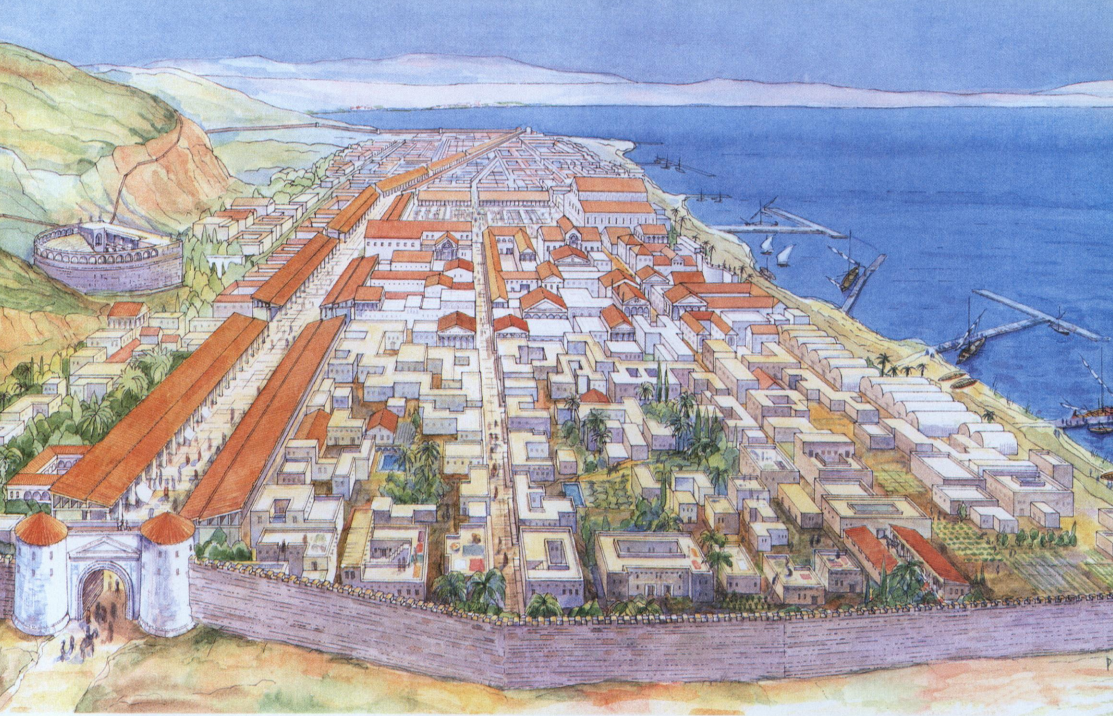
 Figure 14
Figure 14
Proposed reconstruction of the ancient city of Tiberias, looking north
(drawn by Dov Porotzky)
Caption from Hirschfeld and Galor (2007) and image from Atrash (2012)
- Fig. E Roman cardo and
overlaying street from Cytryn-Silverman (2015)

 Figure E
Figure E
Remains of Roman cardo and overlaying street of the Early Islamic street, leading to the mosque through a set of steps. On the left series of shops of the early Islamic period adjacent to the street exposed by B. Ravani in the 1950s
Photo by David Silverman, The New Tiberias Excavation Project.
Cytryn-Silverman (2015)
| Stratum | Period | Date | Notes |
|---|---|---|---|
| I | Late Fatimid | 11th century CE | construction above the collapse caused by an earthquake (in 1033 CE?) |
| II | Early Fatimid | 9th - 10th centuries CE | continued use of the street with shops. |
| III | Abbasid | 8th - 9th centuries CE | a row of shops, the basilica building was renovated. |
| IV | Byzantine–Umayyad | 5th - 7th centuries CE | the eastern wing was added to the basilica building; the paved street; destruction was caused by the earthquake in 749 CE. |
| V | Late Roman | 4th century CE | construction of the basilica complex, as well as the city’s institutions, i. e., the bathhouse and the covered market place. |
| VI | Roman | 2nd - 3rd centuries CE | establishment of the Hadrianeum in the second century CE (temple dedicated to Hadrian that was never completed) and industrial installations; the paving of the cardo and the city’s infrastructure. |
| VII | Early Roman | 1st century CE | founding of Tiberias, construction of the palace with the marble floor on the shore of the Sea of Galilee, opus sectile, fresco. |
| VIII | Hellenistic | 1st - 2nd centuries BCE | fragments of typical pottery vessels (fish plates, Megarian bowls). |
To quantify the seismic hazard across the town of Tiberias we used a methodology in which horizontal-to-vertical spectral ratio from microtremor (the Nakamura’s technique) obtained on a dense measurement grid is utilized to assess the site-specific uniform acceleration spectra. This process of hazard assessment involves: a detailed mapping of the fundamental and other natural frequencies and amplitudes of H/V spectral ratios; compiling geological, geophysical and borehole data and integrating it with H/V observations to develop models of the subsurface at many sites across the study area. The subsurface model serves as an input for computing the expected Uniform Hazard Site-Specific Acceleration Response Spectra at the investigated sites. The final stage is generalizing the hazard by mapping zones that feature similar seismic hazard functions.
Microtremor measurements were carried out at 175 sites, which are characterized by amplification from 2 up to 8 in the frequency range 0.7-8 Hz. The receiver function, which is horizontal-to-vertical spectral ratio obtained from earthquakes (shear wave) confirms the results obtained from microtremor records at three acceleration locations.
H/V ratios, geological data and information from S-velocity refraction profiles enables construction of geological cross sections. Certain sharp differences in the H/V ratios have been interpreted as being associated with a subsurface discontinuity, i.e. fault.
By comparison of the Uniform Hazard Acceleration Spectra calculated for probability of exceedance of 10% during an exposure time of 50 years and a damping ratio of 5% at more the 50 sites and in consideration of the constructed subsurface models, we subjectively divided the study area into eleven zones. The linear spectra for eight zones significantly exceed the design spectra required in the same area by the current Israel Standard 413 (IS-413) in the period range 0.1-0.5 sec.
In the present study we used a three-step process for evaluating site effects and estimating their influence on seismic ground motion (Zaslavsky et al., 2005). At the first step, we performed microtremor measurements on a dense spatial grid and H/V spectral ratios, from which we obtained a spatial distribution of the frequencies at which amplification is likely to occur and the expected level of amplification at those frequencies. H/V spectral ratios of S-waves, often known as receiver functions, generated by earthquakes and recorded at three accelerometer locations are considered in the analysis. At the second step, all available geological information, geophysical and well data are collected and incorporated as an aid to construct subsurface models for different sites within the investigated area. Finally, one-dimensional analytical models [JW: They used SHAKE] are used to predict site-specific acceleration response spectra from future earthquakes. The application of this methodology makes possible reliable assessment of disaster from different earthquakes, especially in the regions where big earthquakes present a long return period, but which exhibit a high seismic risk according to historical reports, population distribution and its socio-economic importance.
With the exception of the Upper Cretaceous rocks exposed in the structural highs of Poriya and Fuliya blocks, all the formations on the geological map are part of the Neogene. From bottom to top these are: the Miocene Hordos Fm. and the Lower Basalt; the Neogene Bira Fm., Gesher Fm. and the Cover Basalt. The investigated area is dissected by two normal fault systems: the WSW-ENE transversal system with the down throw to the north, and the SE-NW system of step-faults with the down throw to the northeast. The two transversal faults in the south are of a Neogene pre-Cover basalt age. They were rejuvenated in the Pleistocene. The NW trending step faults are of Pleistocene post-Cover Basalt age. Along the greater part of their traces they bring basalt against basalt. Only at the southeastern termination of two of them, where they abut against a transversal fault, Neogene sediments rise to the surface. Here the throw of the two step faults is the greatest. A fourth step-fault is inferred within the lake and parallel to its shore. A significant feature is the considerable vertical displacement at the NE corner of the titled block, a result of the cumulative effect of the two fault systems. In the Upper Pliocene, the site of the town and its lakeshore were structurally higher than Tel Maon in the west (Schulman, 1966). Schulman (1966) proposed Ron et al. (1984) supported that the middle to upper Miocene sediments and basalts underwent intensive deformation by horizontal shear in a compressive stress field which operated during the end of the Miocene and early Pliocene times.
The most common technique for estimating site response is the standard (classic) spectral ratio procedure first introduced by Borcherdt (1970). This approach considers the ratio between the Fourier spectra of a seismogram recorded in the site of interest and the spectrum of a seismogram recorded at a reference site, which is usually the rock outcrop. This ratio can be considered as the transfer function between the bedrock and the surface assuming that the two recordings correspond to the same source, the same path effect and that the reference site has a negligible site effect. It is very difficult to implement all these assumptions in real conditions. First, in many cases we do not have a nearby bedrock site and therefore the condition that the path of the propagating seismic waves is the same is not fulfilled; second, it is known (e.g., Steidl et al., 1996, Zaslavsky et al., 2002) that weathered and cracked bedrock site exhibits a significant site effect, associated with frequency-selective ground motion amplification; third, there are many cases in Israel, when nearby bedrock outcrop is not the same rock at the base of the soil layer which is responsible for amplifying seismic waves amplitudes. It should also be noted that performing simultaneous measurements at two sites is often relatively costly. Nevertheless, when all the conditions are observed, this method maybe considered the most reliable estimate of the empirical transfer function of site. Many investigators used this method and evaluated site response functions from moderate to weak motion recording of earthquakes (Tucker and King, 1984; McGarr et al., 1991; Field et al., 1992; Liu et al., 1992; Carver and Hartzell, 1996; Hartzell et al., 1996; Steidl et al., 1996; Zaslavsky et al., 2000 and others).
In this technique applied by Lermo and Chávez-García (1993) the receiver function can be obtained from ratio between horizontal and vertical amplitude spectra computed at the same investigated site from S-waves, respectively. Receiver function was introduced by Langston (1979) to determine the velocity structure of the crust and upper mantle from P-waves of teleseisms. Langston made the assumption that the vertical component of motion is not influenced by the local structure, whereas the horizontal components, owing to the geological layering, contain the P to S conversion. In the spectral domain this corresponds to a simple division of the horizontal spectrum by the vertical. Many studies report that the frequency dependence of site response can thus be obtained from measurements made at only one station at the analysed site (Lermo and Chavez-Garcia 1994; Malagnini et al., 1996; Seekins, et al., 1996; Theodulidis et al., 1996; Castro et al. 1997; Yamazaki and Ansary, 1997; and others). Their results confirm the validity of the method to estimate S-wave site response. We obtained similar conclusion in our investigations (Zaslavsky et al., 2000). Nevertheless, the implementation of this approach still requires a rather frequent occurrence of earthquakes. This requirement becomes an obstacle in regions of low seismicity.
Kagami et al. (1982) proposed that the ratio of the spectra of the horizontal ground motions of the microtremor at the investigated site to those of a reference site can be used as a measure of the site response function. This method can be successfully applied for long period microtremors with period ranging from 1.0 to 10 sec. When higher frequencies are of interest, the distance between the measured sites should not exceed few hundred meters. The reliability of this method depends on whether or not the simultaneously measured motions at each site are from the same source and propagation path. This technique is widely used for site response estimates (Lermo et al., 1988; Field et al., 1990, 1995; Rovelli et al., 1991; Dravinski et al., 1995, 2003; Gaull et al., 1995). However, experimental study of site effect by sediment-to-bedrock spectral ratio in urban and suburban regions can be successful only under particular circumstances, because microtremor would be influenced by local artificial sources generated by human activities which essentially change from place to place.
Nakamura (1989) proposed the hypothesis that site response function under low strain can be determined as the spectral ratio of the horizontal versus the vertical component (H/V) of motion observed at the same site. He hypothesized that the vertical component of microtremor is relatively unaffected by the unconsolidated near-surface layers. Hence, the site response is the spectral ratio between the horizontal component of microseisms and vertical component of microseisms recorded at the same location.
Many authors, among them Lermo and Chávez-García (1994), Seekins et al. (1996), Toshinawa et al. (1997), Chávez-García and Cuenca (1998), Enomoto et al. (2000), Shapira et al. (2001), Mucciarelli and Gallipoli (2004), Murphy and Eaton (2005), Maresca, (2006), show that the H/V spectral ratio technique can be a useful tool for the assessment of ground motion characteristics on soft sediments. However, other authors (for example, Bonilla et al., 1997; Horike et al., 2001; Satoh et al., 2001) conclude that whereas the predominant peak of H/V ratio is well correlated with the fundamental resonance frequency, the amplitude of this peak is not necessarily the amplification level as obtained from sediment-to-bedrock spectral ratio of earthquake records.
In the town of Tiberias, H/V measurements performed on urban noise have been used to quantify soil responses for evaluation of the site specific seismic hazard. Our conclusions may be summarized as follows:
- The stability and reproducibility of measurements are confirmed by data from continuous measurements during several months as well as repeated measurements in different months and years which yield almost identical shapes of average spectral ratios obtained at the same site under the same conditions of measurements.
- Comparison between the average H/V spectral ratios obtained from accelerograms of horizontal components and from microtremor recorded at the same site shows that an appropriate ensemble of carefully selected windows of microtremor provides estimations of site response which are similar to those obtained from seismic events.
- Experimental estimation of the site response over Tiberias yields variation in the fundamental frequency in the range 0.7-7 Hz and H/V amplitude from 2 up to 8. Maps of the spatial distribution of the fundamental frequency and their associated H/V amplitude delineate potentially vulnerable sites. This information is useful for land use considerations in urban planning and for identifying sites which require in depth site investigations to better evaluate the seismic hazard.
- Limited data on S-wave velocities and sediment thickness of the upper layers obtained from seismic refraction surveys used to calibrate the H/V spectral ratio with an analytical site response derived from a 1D subsurface model. It is also used to justify further H/V ratios utilization, by velocities extrapolation, to study other sites, away from refraction profiles and boreholes. A stochastic optimization algorithm is applied to calculate the layer thickness, yielding transfer functions to match in the best way the observed H/V curves, considering all resonance peaks. Two cross-sections in Tiberias illustrate the results of H/V analysis.
- The microtremor measurements enable identifying discontinuity in the subsurface and locate faults. These are associated with significant change in fundamental frequency, amplitude and shape corresponding to both vertical displacement and change in the velocity profile. Some, but not all faults detected by H/V analysis are identified also by geological data.
- Analytical models cross-checked with observed data were extrapolated over the study area and integrated into computations of the uniform site specific acceleration response spectra for a probability of exceedence of 10% during exposure time of 50 years and damping of 5%. The sites with common site effect characteristics were united into zones. In eight out of eleven selected zones the current Building Code IS-413 significantly underestimates the acceleration in the period range 0.1-0.6 sec.
- Since 2000 when strong motion stations were installed in the Tiberias area, two local earthquakes that occurred in 2004 were recorded. Taking into account the complicated geology of the region, we strongly recommend deploying seismic stations for continuous recording weak earthquakes to validate and improve the subsurface models derived from microtremor analysis and contribute to seismic hazard assessment.
- We should emphasize that calculated analytical transfer functions are associated with weak motions and linear behavior of soils. Non-linear characteristics of site in Tiberias are beyond the scope of this study. Nevertheless, based on the result presented above nonlinear site response can be determined by different mathematical models of soil nonlinearity, making use of the models developed for each zone. In that respect, the microzonation maps developed in this study are also relevant for the prediction of ground motions from earthquakes of high magnitudes.
 Figure 3
Figure 3Location of the measurement sites in the study area. Numbers indicate the sites used as examples. TB-1, TB-2 and TB-3 - refraction survey profiles (Ezersky, 2008); R-1 and R-2 – refraction survey profiles (Schtivelman, 1995); TVR, TVR2 and POR – accelerometer locations; Profile1 and Profile2 – profiles for reconstructing subsurface structure.
Zaslavsky et al. (2009a)
 Figure 15
Figure 15Distribution of the fundamental resonance frequency over Tiberias.
Zaslavsky et al. (2009a)
 Figure 16
Figure 16Distribution of amplitude associated with the fundamental frequency
Zaslavsky et al. (2009a)
 Table 2
Table 2Brief description of wells located in the Tiberias region
Zaslavsky et al. (2009a)
 Table 4
Table 4Geophysical and analytical models for calculating transfer functions at points located along TB-3 refraction profile
Zaslavsky et al. (2009a)
 Table 5
Table 5Geophysical and analytical models for calculating transfer function at sites located along refraction profile TB-1.
Zaslavsky et al. (2009a)
 Table 6
Table 6Geotechnical data obtained from refraction surveys carried out in 1995 and 2008.
Zaslavsky et al. (2009a)
 Table 7
Table 7Soil-column model for sites along refraction profile TB2
Zaslavsky et al. (2009a)
 Table 10
Table 10Ranges of S-wave velocities for litho-stratigraphycal units represented in the study area and used in calculating site response.
Zaslavsky et al. (2009a)
 Figure 23
Figure 23Schematic geological NS cross section beneath profile 1
Zaslavsky et al. (2009a)
 Figure 25
Figure 25Schematic geological EW cross section along profile 2
Zaslavsky et al. (2009a)
 Figure 27
Figure 27Seismic microzoning map of Tiberias presenting zones of common site effect characteristics.
Zaslavsky et al. (2009a)
Cytryn-Silverman, K, 2015, “Tiberias, from its foundation to the early Islamic period,”
in Galilee in the Late Second Temple and Mishnaic Periods Volume 2: The Archaeological Record from Galilean Cities,
Towns, and Villages, edited by David A. Fiensy and James Riley Strange, Minneapolis, 2015, pp.186-210.
Ferrario, M. F., et al. (2020). The mid-8th century CE surface faulting along the Dead Sea Fault at Tiberias (Sea of Galilee, Israel)
Tectonics Research Article
Zaslavsky et al. (2009a) SITE EFFECT AND SEISMIC HAZARD MICROZONATION ACROSS THE TOWN OF TIBERIAS
Geophysical Institute of Israel Report No 502/416/09
Zohar (2017) A city hit by an earthquake: an HGIS approach to reconstructing the damage in Tiberias (Israel) in 1837
Hirschfeld, Y. and O. Gutfeld (2008).
"TIBERIAS: EXCAVATIONS IN THE HOUSE OF THE BRONZES: Final Report, Volume I: Architecture, Stratigraphy and Small Finds." Qedem 48 - at JSTOR
Hirschfeld, Y. and O. Gutfeld (2008).
"TIBERIAS: EXCAVATIONS IN THE HOUSE OF THE BRONZES: Final Report, Volume I: Architecture, Stratigraphy and Small Finds." Qedem 48 - open access at academia.edu
Hirschfeld, Y. and O. Gutfeld (2013).
"TIBERIAS: EXCAVATIONS IN THE HOUSE OF THE BRONZES: Final Report, Volume II: The Fatimid Metalwork Hoard from Tiberias" Qedem 55 - at JSTOR
Maria Francesca Ferrario at ResearchGate
Webpage for Dr. Katia Cytryn-Silverman at the Institute of Archaeology at
the Hebrew University of Jerusalem
academia.edu page for Katia Cytryn
Tiberias at BibleWalks.com
Tiberias South Gate at BibleWalks.com
Tiberias Theater at BibleWalks.com
Hammat Tiberias at BibleWalks.com
Berniki Hill at BibleWalks.com
Tiberias Excavations facebook page
Site dedicated to the preservation of Ancient Tiberias (in Hebrew)
M. Avi-Yonah, IEJ I (1950-1951), 160-169
D. Ussishkin, ibid. 18 (1968), 45-46
B. Lifshitz,
Euphrosyne n.s. 6 (1973-1974), 23-27
G. Foerster, RB 82 (1975), 105-109
id., Recherches Archeologiques
en Israel 206-209
E. Ballhorn, Israel-Land and Nature 1 (1976), 151-153
A. Bruno\, BTS 192 (1977),
10-20
L. I. Levine, HUCA 49 (1978), 143-185
M. Ben-Dov, ASR, 157-159
N. Feig, ES/1 (1982), 110;
S. Dar, ibid. 2 (1983), 103
id., IEJ33 (1983), 114-115
A. Harif, PEQ 116(1984), 103-109
J-F. Desclaux,
MdB 38 (1985), 45-47
G. Theissen, ZDPV 101 (1985), 43-55
S. Qedar, Israel Numismatic Journa/9
(1986-1987), 29-33
H. Dudman and E. Ballhorn, Tiberias, Jerusalem 1988
D. Stacey, BAlAS 8 (1988-
1989), 21-33
A. Cohen, ES/9 (1989-1990), 171
Y. Hirschfeld, ibid., 107-109
id., BAR 17/2 (1991), 44-
51
id., MdB 72 (1991), 21-23
BA 54 (1991), 170-171.
Y. Hirschfeld, A Guide to the Antiquity Sites in Tiberias, rev. ed., Jerusalem 1992
ibid.
(Review) PEQ 130 (1998), 79
id. (et al.), Excavations at Tiberias, 1989–1994 (IAA Reports 22), Jerusalem
2004
id., Roman, Byzantine, and Early Muslim Tiberias: A Handbook of Primary Sources, Tiberias 2005;
D. A. Stacey, The Archaeology of Early Islamic Tiberias (Ph.D. diss.), London 1995
id., Excavations at
Tiberias, 1973–1974: The Early Islamic Periods (IAA Reports 21), Jerusalem 2004
ibid. (Review) PEQ
137 (2005), 182–183
Y. Stepansky, Map of Tiberias (39) (Archaeological Survey of Israel), Jerusalem (in
prep.).
Y. Hirschfeld, ESI 10 (1991), 91–93
16 (1997), 35–42
id., OEANE, 5, New York 1997, 203–206;
id., RB 106 (1999), 236–249
[id.], Artifax 19/2 (2004), 6
G. Labee, Revue des Études Anciennes 93 (1991),
277–297
A. Lester, Jewellery and Goldsmithing in the Islamic World: International Symposium, The Israel
Museum, 1987 (Israel Museum, Catalogue 320
ed. N. Brosh), Jerusalem 1991, 21–29
A. Onn, ESI 10
(1991), 10
id., ibid. (1992), 166–167
Y. Stepansky, ESI 9 (1991), 79 (with E. Damati)
id., ibid., 70–80
(with Z. Ilan)
E. J. Simpson et al., ibid., 4
V. Bernie et al., Levant 24 (1992), 95–129
T. P. Harrison,
JNES 51 (1992), 51–59
Z. Razi & E. L. Braun, The Horns of Hattin: Proceedings of the 2nd Conference
of the Society for the Study of the Crusades and the Latin East, Jerusalem and Haifa, 2–6.7.1987 (ed. B.
Z. Kedar), Jerusalem 1992, 216–227
J. F. Strange, ABD, 6, New York 1992, 547–549
N. Feig, LA 44
(1994), 591–594
M. L. Fischer, Mediterranean Language Review 8 (1994), 20–40
R. A. Horsley, Galilee:
History, Politics, People, Valley Forge, PA 1995
id., Archaeology, History and Society in Galilee: The
Social Context of Jesus and the Rabbis, Valley Forge, PA 1996
E. Damati, ESI 16 (1997), 138–139 (with
Y. Stepansky)
‘Atiqot 35 (1998), 152–153
ibid., 38 (1999), 227–228
N. Brosh, ibid. 36 (1998), 1–9
L.
Di Segni, Heraica: miscellanea di studi (S. J. Sierra Fest.
eds. F. Israel et al.), Torino 1998, 115–163
D.
Pringle, The Churches of the Crusader Kingdom of Jerusalem: A Corpus, 2, Cambridge 1998, 351–366;
B. -Z. Rosenfeld, HUCA 69 (1998), 57
Y. Alexandre, ‘Atiqot 37 (1999), 171*
H. Ben Nahum, ESI 109
(1999), 15*–16*
Y. Stepansky, ibid. 19 (1999), 226–227
20 (2000), 19*–20*
id., JSRS 9 (2000), xvii–xviii;
id., Crusades 3 (2004), 179–181
Z. Weiss, Religious and Ethnic Communities in Later Roman Palestine
(Studies and Texts in Jewish History and Culture 5
ed. H. Lapin), Bethesda, MD 1998, 219–246
B. Bagatti,
Ancient Christian Villages of Galilee (SBF Collectio Minor 37), Jerusalem 2001, 47–56
S. S. Miller
Historia (Stuttgart) 50 (2001), 453–467
E. M. Smallwood, The Jews Under Roman Rule from Pompey to
Diocletian: A Study in Political Relations, Boston 2001 (index)
T. Weber, SHAJ 7 (2001), 531–537
MdB
147 (2002), 57
M. Rosen-Ayalon, Art et archéologie islamiques en Palestine, Paris 2002, 84–89, 152–153;
Z. S. Winogradov, The Aqueducts of Israel, Portsmouth, RI 2002, 295–304
C. MacEvitt, Albright News 8
(2003), 15–16
id., ASOR Newsletter 53/3 (2003), 15–16
S. Fortner, Leben am See Gennesaret, Mainz am
Rhein 2003, 86–92
BAR 30/4 (2004), 12
E. Dvorjetski, ibid., 16–27, 60
Y. Elitzur, Ancient Place Names
in the Holy Land: Preservation and History, Jerusalem 2004, 64–71
N. Hazan et al., Israel Journal of
Earth Sciences 53 (2004), 199–205
G. Mazor, Free Standing City Gates in the Eastern Provinces during
the Roman Imperial Period (Ph.D. diss.), Ramat-Gan 2004 (Eng. abstract)
J. Sudilovsky (& Y. Stepansky),
BAR 30/3 (2004), 16–17
J. Zangenberg, Jahrbuch des Deutschen Evangelischen Instituts für Altertumswissenschaft des Heiligen Landes 10 (2004), 195
Artifax 20/4 (2005), 6–7
P. Gruson, MdB Hors Série 2005,
25
L. I. Levine, The Ancient Synagogue: The First Thousand Years, 2nd ed., New Haven, CT 2005, 52–54;
A. Lewin, The Archaeology of Ancient Judea and Palestine, Los Angeles, CA 2005, 74–79
K. Van Eickels,
Saladin und die Kreuzfahrer (Publikationen der Reiss-Engelhorn-Museen 17
Schriftenreihe des Landesmuseums für Natur und Mensch, Oldenburg, 37
eds. A. Wieczorek et al.), Mainz am Rhein 2005, 304–312.
E. Janis, The Shekel 24/3 (1991), 18–21
P. Soucek, The Glory of Byzantium: Art and Culture of the Middle
Byzantine Era, A.D. 843–1261 (eds. H. C. Evnas & W. D. Wixom), New York 1997, 403–433
D. J. Wasserstein, ESI 36 (1998), 15–22
G. Bijovsky, International Numismatic Newsletter 34 (1999), 3
A. Kindler,
Bethsaida: A City by the North Shore of the Sea of Galilee, 2 (Bethsaida Excavations Project Reports & Contextual Studies 2
eds. R. Arav & R. A. Freund), Kirksville, MO 1999, 245–268
R. Milstein & D. T. Ariel,
Excavations at Tiberias, 1989–1994 (IAA Reports 22
ed. Y. Hirschfeld), Jerusalem 2004, 57–58.
Y. Hirschfeld et al., Excavations at Tiberias, 1989–1994, II: The Excavations on Mount Berenice, 1990–1994 (IAA Reports 22), Jerusalem 2004, 73–232.
Y. Hirschfeld, MdB 72 (1991), 21–23
id., BA 57 (1994), 122–133
id., ESI 14 (1994), 33–37
16
(1997), 35–42 (with R. Ben-Arieh)
id., AJA 98 (1994), 512–513
id., Michmanim 8 (1995), 11*–12*
id., RB
106 (1999), 236–249
R. Ben-Arieh, BA 57 (1994), 134–137
id., ESI 14 (1994), 37–38
16 (1995), 41–42
R.
Fishman-Duker, MdB 92 (1995), 38–39
M. Aviam, Galilee through the Centuries: Confluence and Cultures
(Duke Judaic Studies Series 1
ed. E. M. Meyers), Winona Lake, IN 1999, 297
U. Dotterweich, Ungentarien
mit Kuppelförmiger Mündung aus Knidos (Knidos Studien 1), Möhnesee 1999.
BAR 25/1 (1999), 18
G. Bijovsky, International Numismatic Newsletter 34 (1999), 3
L. Shulman, The Digging Stick 16/3 (1999), 10–11
J. Sudilovsky, BAR 25/6 (1999), 14
W. Watzman, Archaeology 52/2 (1999),
34
Y. Hirschfeld & O. Gutfeld, ESI 112 (2000), 15*–17*
F. Mebarki, MdB 125 (2000), 64.
